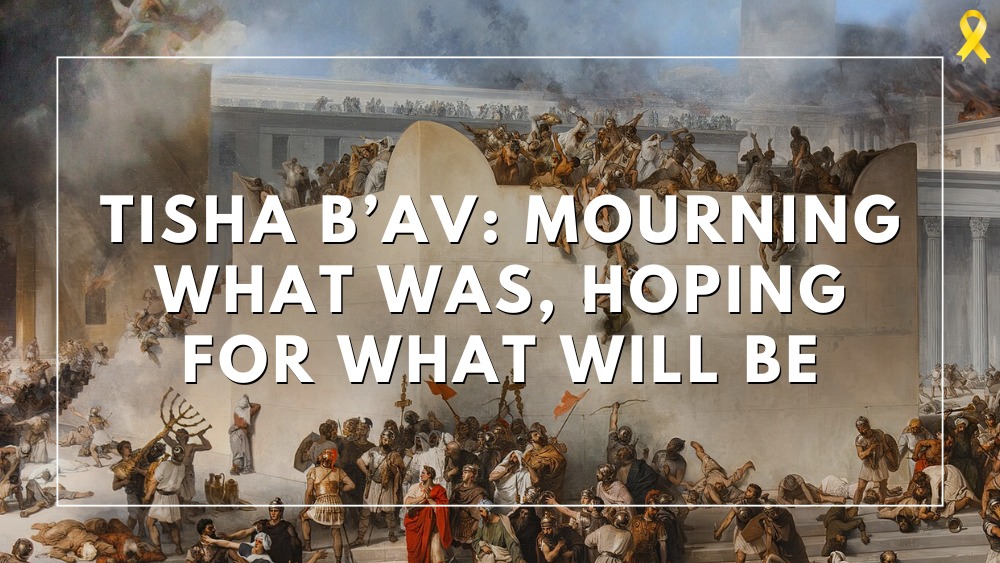
By HFI staff
There is a day on the Jewish calendar marked not by celebration, but by sorrow. A day set aside to grieve the loss of what once was: a sacred place, a divine closeness, a center of spiritual life. That day is Tisha B’Av, the ninth day of the Hebrew month of Av. It is a fast and a day of mourning unlike any other.
On this day, the memory of destruction weighs heavy. The First Temple in Jerusalem fell to the Babylonians, and centuries later, the Second Temple fell to the Romans. Both tragedies struck on the same date, generations apart, yet linked by a deep sense of rupture.
The Temple was more than stone and sacrifice. It was a meeting point between heaven and earth, a place where the divine presence was believed to dwell among people. Its destruction was not just the loss of a building, but a spiritual dislocation. The grief expressed in ancient texts still echoes today:
“How deserted lies the city, once so full of people!”
(Lamentations 1:1)
A Long History of Loss
Over time, the ninth of Av has come to symbolize more than the destruction of sacred space. It has become a day of remembering every wound that history has inflicted, from exile to persecution, from displacement to disaster. It is a collective acknowledgment of pain carried through generations, of dreams shattered and lives uprooted.
And yet, Tisha B’Av is not just a day of grief. It is a mirror. It reflects the human experience of living between what was and what is not yet. It speaks to every person who has known brokenness, who has felt the silence after loss, who has asked where God is in the ruins.
A Time to Sit Low and Look Up
Tisha B’Av is marked by solemn practices meant to reflect the depth of mourning. From sunset to sunset, many refrain from eating and drinking. Traditional observance includes sitting on the floor or on low stools, avoiding leather shoes, skipping bathing, music, greetings, or other comforts.
At night, people gather in dim spaces to read Eicha (Lamentations) aloud, often by candlelight or soft lamplight. The reading is slow and mournful. The mood is quiet and heavy. These customs are not just ritual. They are physical expressions of spiritual sorrow that allow individuals and communities to fully enter the weight of the day.
A People Who Kept Going
Even in the wake of destruction, the people did not disappear. They adapted. They carried the sacred forward through memory, prayer, and tradition. They turned homes and study halls into new places of spiritual connection. They mourned without losing faith, and they waited without surrendering hope.
Tisha B’Av is not only a memorial to what was lost. It is a testimony to the strength to endure, to mourn with faith, and to keep the light alive across generations.
The Gift of Lament
In a world that often rushes to move on, Tisha B’Av invites something different. It gives space to grieve. It honors sorrow as a part of faith, not a failure of it. It reminds us that mourning is not weakness. It is truth telling.
To lament is to acknowledge what is broken. It is a spiritual act that clears space for healing, softens the heart, and opens the soul to the possibility of renewal.
A Quiet Moment
In a small synagogue, the lights were dimmed. People sat on the floor, backs against the walls, quietly chanting the verses of Lamentations. One young child whispered to her father, “Why are we sitting down?” He replied, “Because we are remembering when we fell down. And waiting to stand again.”
A Future Still Promised
Even at its most sorrowful, Tisha B’Av is not a dead end. Tradition teaches that in the ashes of this day lies the seed of future joy. The very date of mourning is believed to one day become a day of rejoicing. What was lost can, in time, be restored.
The vision of rebuilding is still alive. A renewed Jerusalem. A world made whole again. Divine presence returned to dwell among people. This is not a naïve hope. It is a resilient one. It says that even after devastation, we do not give up on redemption.
Tisha B’Av challenges us not to turn away from the pain of the world, but to sit with it. To feel it. To learn from it. And then, to rise from it with a renewed longing for what could be.

